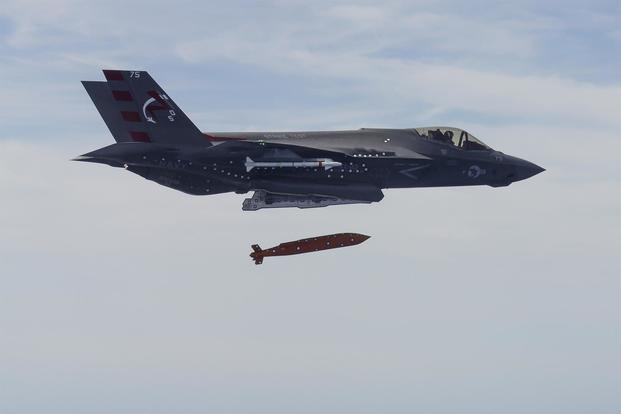NATIONAL HARBOR, Md. -- Raytheon Co.'s Joint Standoff Weapon version C is nearly ready for the U.S. Navy's F-35 Joint Strike Fighter.
The defense company recently integrated the 1,000-pound precision air-to-ground weapon, known as JSOW-C, during a developmental test in the fighter, said Mark Borup, of Raytheon's medium-range strike and attack air warfare systems division.
JSOW-C now must complete operational testing before it is declared combat ready, Borup said.
"This is absolutely a critical opportunity for the Navy because now this is their top-line, medium-range precision strike weapon that is capable now of being integrated and is being integrated internally on JSF," Borup said in an interview Tuesday. He spoke with Military.com during the annual Sea-Air-Space exposition here.
Related content:
-
Navy Confirms Plans to Send Carrier-Capable F-35C to Iwakuni by 2021
-
Marine F-35Bs Arrive on USS Wasp for First Shipboard Deployment
Borup said the F-35 is now able to penetrate targets in total stealth mode since JSOW-C -- carried internally in the weapons bay -- is also configured with low-observable technology.
"The great thing about JSOW is that mixed loads can be carried" in the aircraft, he said, noting this means the Joint Strike Fighter could carry air-to-air and air-to-ground weapons at the same time.
At maximum, two JSOW-Cs can be carried in the F-35C.
A live developmental test was completed earlier this year in the Western United States, Borup said. Operational testing is expected to be done by the end of 2018.
The F-35C -- designed to take off and land on aircraft carriers -- is not expected to reach initial operating capability until 2019. When asked how this affects JSOW incorporation, Borup said Raytheon is working with the service as the aircraft's own testing continues.
"Those are kind of going along in parallel steps and, as the aircraft is ready to accept certain capabilities, then we move forward," he said.
The weapon was tested with the aircraft's Block 3F configuration software.
"It's already to go in the next phases," he said.
JSOW-C, using a GPS-navigation system and thermal imaging infrared seeker, is already used in the F/A-18 Super Hornet, which gave Raytheon additional test data and insights during F-35 configuration.
The missile uses a tandem warhead to blow through hardened surface targets like bunkers: The first compartment has a forward-shaped, 220-pound charge to penetrate, and a secondary compartment features a 320-pound follow-through bomb.
"It has a smart fuse, so you can pick the level of penetration desired," Borup said.
The missile can also be programmed to have different effects, such as waypoints or dive angles, he said.
"You want the flexibility to have one weapon that can meet a broad range of targets, whether it’s to penetrate a bunker or maybe its aircraft on a tarmac. … So it's optimized for a large number of targets," Borup said.
-- Oriana Pawlyk can be reached at oriana.pawlyk@military.com. Follow her on Twitter at @Oriana0214










